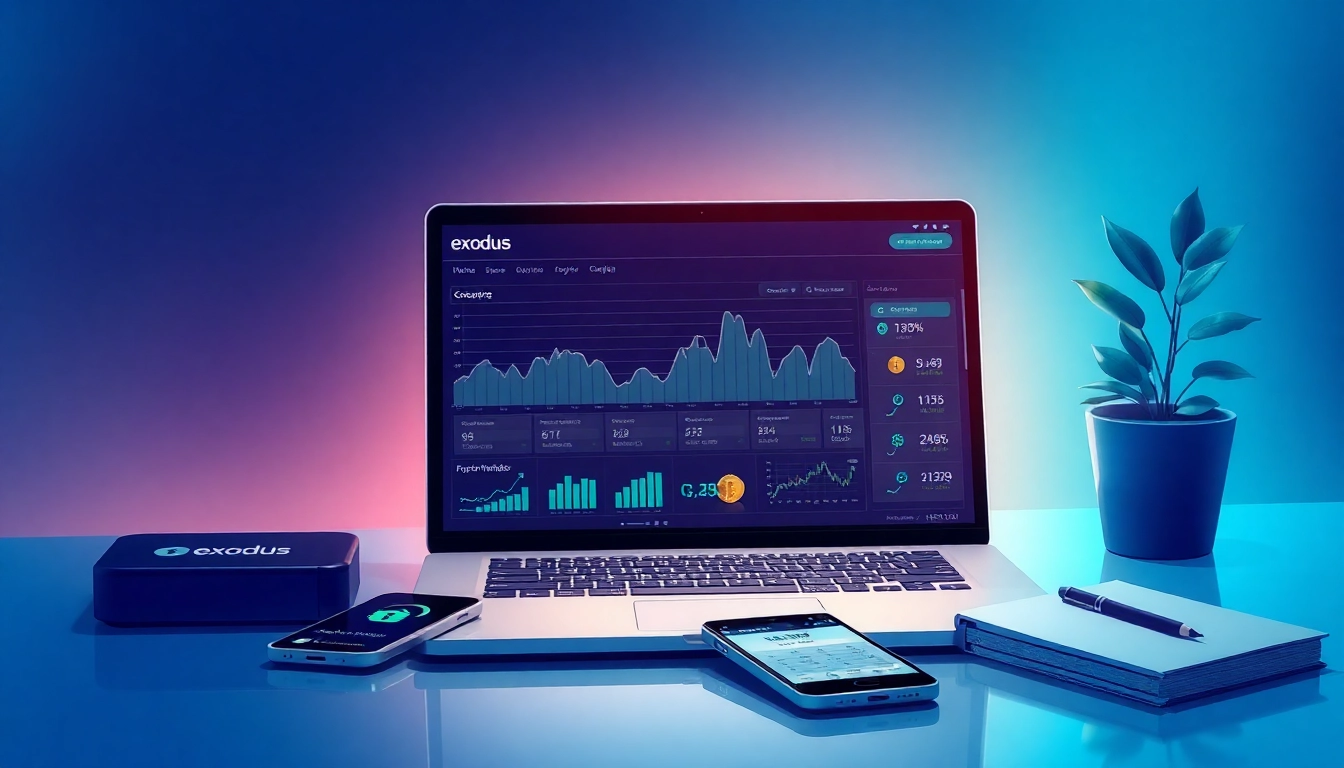Introduction to Exodus Wallet
In the rapidly evolving world of cryptocurrency, selecting the right wallet can significantly influence your experience and security. Enter the exodus wallet, a user-friendly option for managing various digital assets efficiently. Exodus Wallet has gained popularity among crypto enthusiasts for its intuitive design and robust features. This article aims to delve into the essential aspects of Exodus Wallet, helping you understand its operation, benefits, security features, and much more.
What is Exodus Wallet?
Exodus Wallet is a software wallet designed primarily for the storage, management, and exchange of digital currencies. Launched in 2015, it allows users to handle over 100 cryptocurrencies, making it a versatile choice for novice and experienced traders alike. With its impressive interface and seamless integration with various services, Exodus simplifies the often convoluted world of cryptocurrency management. Exodus Wallet operates as a hot wallet, meaning it remains connected to the internet, allowing users to transact easily while being aware of the security implications that come with such a feature.
Key Features of Exodus Wallet
Exodus Wallet comes packed with numerous features that cater to both beginners and seasoned cryptocurrency users. Below are the standout features:
- User-Friendly Interface: Exodus boasts an attractive and easy-to-navigate interface, making it accessible for those new to cryptocurrency.
- Multi-Currency Support: Users can manage over 100 cryptocurrencies within a single wallet.
- Built-in Exchange Functionality: The wallet allows users to swap cryptocurrencies directly within the app without needing an external exchange.
- Built-in Portfolio Tracker: Users can easily keep track of their holdings, visualize asset allocations, and stay updated on market trends.
- 24/7 Customer Support: Exodus offers robust customer service, assisting users with queries related to their wallets.
- Integration with Hardware Wallets: For added security, Exodus can be integrated with various hardware wallets to provide a more secure storage option.
- Mobile and Desktop Versions: The wallet is available on both desktop and mobile platforms, ensuring users can manage their assets anywhere.
Why Choose Exodus Wallet Over Others?
When it comes to selecting a cryptocurrency wallet, the plethora of available options can be overwhelming. Here’s why Exodus stands out:
- No Signup Required: Exodus does not need users to create an account or provide personal information, ensuring user privacy.
- Access to Web3: Exodus has expanded to support Web3, enabling functionalities such as decentralized finance (DeFi) interactions.
- Constant Updates and Improvements: The Exodus team consistently updates the software, adding features and improving security protocols.
- Intuitive Design Perfect for Beginners: New users can quickly learn to navigate the wallet without any steep learning curve.
Getting Started with Exodus Wallet
Step-by-Step Installation Guide
Installing Exodus Wallet is a straightforward process. Here’s how to get started:
- Visit the official Exodus website to download the application suitable for your operating system (Windows, Mac, or Linux).
- After downloading, locate the installer file and launch it to start the installation process.
- Follow the installation prompts to complete the setup.
- Upon installation, launch the Exodus application. You will be greeted with a welcome screen.
- Choose to create a new wallet, which will lead you to the seed phrase setup.
Creating Your First Wallet
Creating a wallet in Exodus is an essential step for managing your cryptocurrency effectively:
- During initialization, you will receive a unique recovery phrase. Ensure you write it down and store it safely; this phrase is critical for recovering your wallet.
- Next, confirm your recovery phrase by selecting the words in the correct order. This step guarantees that you have securely noted your recovery details.
- Once confirmed, your wallet will be set up, and you can start receiving or sending cryptocurrencies.
Understanding Wallet Security Basics
Understanding the fundamental security concepts is crucial to safeguarding your digital assets:
- Backup Your Wallet: Always back up your recovery phrase and wallet data to ensure you can recover your wallet in case of device loss or failure.
- Strong Password Selection: Set a strong password that combines letters, numbers, and special characters to enhance security.
- Keep Software Updated: Regularly update your Exodus wallet to benefit from security patches and new features.
- Understand Phishing Attacks: Stay informed about phishing risks and always verify the websites and emails that seek personal information.
Managing Cryptocurrencies in Your Exodus Wallet
How to Swap Cryptocurrencies
Exodus simplifies the process of exchanging cryptocurrencies within the wallet itself:
- Open the Exodus Wallet application and navigate to the “Exchange” tab.
- Select the cryptocurrency you wish to swap from the dropdown menu.
- Next, choose the currency you want to receive.
- Enter the amount you would like to exchange and review the details, including the exchange rates and fees.
- Confirm the transaction, and the process will initiate. You will be notified once the swap is complete.
Staking and Earning with Exodus Wallet
Exodus Wallet allows users to earn passive income through staking. This feature enables users to lock their assets and earn rewards over time. Here’s how to get started with staking:
- Navigate to the “Earn” section within the wallet.
- Select the cryptocurrency you want to stake, and review the terms, including lock-up periods and expected rewards.
- Confirm your selection and initiate the staking process. Your staked assets will earn rewards, visible in your portfolio.
Tracking Your Portfolio Effectively
One of the salient features of Exodus is its comprehensive portfolio tracker, which offers various metrics to help you navigate your investments:
- Portfolio Composition: View your current holdings, their values, and changes over time.
- Market Insights: Access real-time price data and market analyses to make informed decisions.
- Historical Performance: Review past performance metrics to evaluate the growth of your investments.
Security Measures for Exodus Wallet Users
Best Practices for Keeping Your Wallet Safe
Implementing best practices in wallet management is crucial for ensuring security. Here are effective measures:
- Use a Hardware Wallet: Consider integrating Exodus with a hardware wallet for enhanced security.
- Regular Backups: Regularly back up your wallet and recovery phrase.
- Be Cautious with Public Wi-Fi: Avoid accessing your wallet on public networks to minimize exposure to potential attacks.
- Enable Two-Factor Authentication (2FA): Utilize 2FA whenever possible for an extra layer of security.
Understanding Hot Wallet vs. Cold Wallet
Understanding the distinction between hot and cold wallets can help users make informed choices regarding asset storage:
- Hot Wallet:
- A wallet that remains connected to the internet, allowing for easy access and transaction capabilities. However, it risks exposure to hacks.
- Cold Wallet:
- A wallet that is offline and thus provides a higher level of security against cyber threats. Examples include paper wallets and hardware wallets.
Responding to Security Breaches
Despite taking precautions, security breaches can occur. Here’s how to respond effectively:
- Immediately change your passwords and security settings.
- Notify relevant exchanges if you believe your account has been compromised.
- Monitor your wallet and accounts for any unauthorized transactions.
- Consider moving your assets to a more secure wallet, such as a hardware wallet.
Advanced Features and Future Enhancements of Exodus Wallet
Integrating with Hardware Wallets
The integration of Exodus Wallet with hardware wallets provides users with enhanced security. This setup allows users to manage their assets from a convenient software interface while keeping the private keys offline. Popular hardware wallets compatible with Exodus include:
- Trezor
- Ledger Nano S
- Ledger Nano X
To integrate, users need to connect their hardware wallet to the Exodus application and follow the prompts to establish a secure connection for managing their assets.
Upcoming Features and Roadmap
The Exodus team is continuously innovating and has a roadmap that includes:
- Enhanced DeFi functionality for users to engage with decentralized services directly from the wallet.
- Improved integrations with more cryptocurrencies and tokens.
- New security features aimed at educating users about potential threats and also improving methods of storing and accessing their assets securely.
User Feedback and Community Enhancements
User feedback plays a pivotal role in shaping the future of Exodus Wallet. The team actively encourages users to share their experiences. By integrating popular suggestions, they strive to enhance user satisfaction. Some initiatives based on user feedback include:
- Regular updates to the user interface for improved usability.
- Increased educational resources to help new users understand crypto management better.
- Expanded customer support for faster resolution of inquiries.


